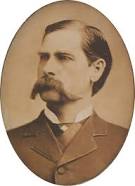 Wyatt Berry Stapp Earp was born March 19, 1848, and died January 13, 1929. He was an Old West lawman and gambler who worked in a wide variety of trades throughout his life and took part in the famous gunfight at the O.K. Corral, during which lawmen killed three outlaw Conchise County Cowboys. He is often erroneously regarded as the central figure in the shootout, although his brother Virgil was the Tombstone City and Deputy U.S. Marshal that day, and had far more experience in combat as a sheriff, constable, marshal, and soldier.
Wyatt Berry Stapp Earp was born March 19, 1848, and died January 13, 1929. He was an Old West lawman and gambler who worked in a wide variety of trades throughout his life and took part in the famous gunfight at the O.K. Corral, during which lawmen killed three outlaw Conchise County Cowboys. He is often erroneously regarded as the central figure in the shootout, although his brother Virgil was the Tombstone City and Deputy U.S. Marshal that day, and had far more experience in combat as a sheriff, constable, marshal, and soldier.Earp had many other interests besides being a professional gambler, teamster, and buffalo hunter. During his life he was a lawman, buffalo hunter, saloon keeper, miner, boxing referee, gambler, brothel keeper
As an entrepreneur he owned several saloons, maintained a brothel, mined for silver and gold, and refereed boxing matches. He spent his early life in Pella, Iowa. In 1870, he married Urilla Sutherland, who contracted typhoid fever and died in childbirth. During the next two years, Earp was arrested for stealing a horse, escaped from jail, and was sued twice. He was arrested and fined three times in 1872 for "keeping and being found in a house of ill-fame". His third arrest was described at length in the Daily Transcript, which referred to him as an "old offender" and nicknamed him the "Peoria Bummer," another name for loafer or vagrant.
By 1874, he arrived in the boomtown of Wichita, Kansas, where his wife opened a brothel.On April 21, 1875, he was appointed to the Wichita police force and developed a solid reputation as a lawman, but he was fined and dismissed from the force after getting into a fistfight with a political opponent of his boss. Earp immediately left Wichita, following his brother James to Dodge City, Kansas, where he became an assistant city marshal. In the winter of 1878, he went to Texas to track down an outlaw, and he met John Doc Holliday, whom Earp credited with saving his life.

Earp moved constantly throughout his life from one boomtown to another. He left Dodge City in 1879 and moved with brothers James and Virgil to Tombstone, where a silver boom was underway. The Earps clashed with an informal group of outlaws known as the "Cowboys." Wyatt, Virgil, and younger brother Morgan held various law-enforcement positions which put them in conflict with Tom McLaury, Frank McLaury, Ike Clanton and Billy Clanton who threatened to kill the Earps on several occasions. The conflict escalated over the next year, culminating in the shootout at the O.K. Corral on October 26, 1881, where the Earps and Doc Holliday killed three Cowboys. During the next five months, Virgil was ambushed and maimed, and Morgan was assassinated. Wyatt, Earp, Warren Earp, Doc Holliday, and others formed a federal posse  which killed three more Cowboys whom they thought responsible. Wyatt was never wounded in any of the gunfights, unlike his brothers Virgil and Morgan or his friend Doc Holliday, which only added to his mystique after his death.
which killed three more Cowboys whom they thought responsible. Wyatt was never wounded in any of the gunfights, unlike his brothers Virgil and Morgan or his friend Doc Holliday, which only added to his mystique after his death.
 which killed three more Cowboys whom they thought responsible. Wyatt was never wounded in any of the gunfights, unlike his brothers Virgil and Morgan or his friend Doc Holliday, which only added to his mystique after his death.
which killed three more Cowboys whom they thought responsible. Wyatt was never wounded in any of the gunfights, unlike his brothers Virgil and Morgan or his friend Doc Holliday, which only added to his mystique after his death.Earp died on January 13, 1929. Known as a Western lawman, gunfighter, and boxing referee, he had a notorious reputation for both his handling of the Fitzsimmons–Sharkey fight and his role in the O.K. Corral gunfight. This began to change only after his death when the extremely flattering biography Wyatt Earp: Frontier Marshal was published in 1931, becoming a bestseller and creating his reputation as a fearless lawman. Since then, Earp has been the subject of numerous films, television shows, biographies, and works of fiction which have increased both his fame and his notoriety. Long after his death, he has many devoted detractors and admirers. His modern-day reputation is that of the Old West's toughest and deadliest gunman.
